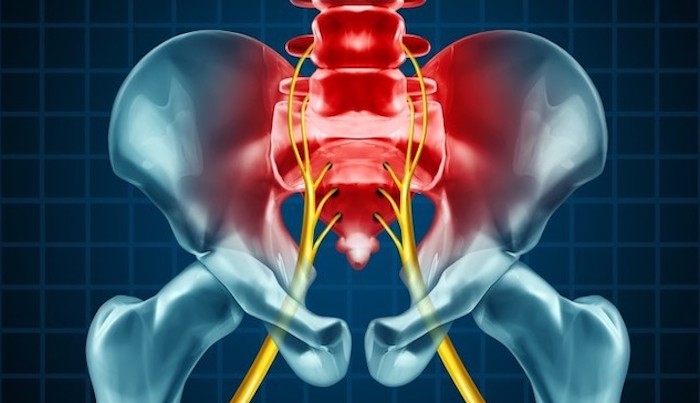
Coccydynia, commonly called tailbone pain refers to persistent pain at the very bottom of your spine. You may develop this pain after direct trauma or spontaneously without a specific inciting factor. The pain typically lasts for weeks to months and can become debilitating.
This blog outlines all you need to know about your tailbone (coccyx), including the specific causes, symptoms, and treatments for tailbone pain.
The Importance of Your Tailbone
This triangular bone at the terminal end of your spine typically consists of 3 to 5 fused bony segments. The bone forms a joint with the sacrum above and has limited movement. The primary functions of the tailbone are to:
- Provide attachment to several muscles and ligaments in your pelvic region
- Support the floor of your pelvis
- Provide voluntary bowel control
- Facilitate natural childbirth (in women) by moving backward
The coccyx is well innervated and can become a significant source of pain if injured.
5 Possible Causes of Tailbone Pain
Coccyx pain can develop from direct trauma, repetitive injury, or degeneration of the joint(s) of the coccyx. Here are 5 possible causes of tailbone pain:
1. Coccyx Bruising, Fracture, Or Dislocation
Damage to the bony segments or ligaments of the coccyx may occur due to:
- Direct trauma to the buttocks, such as by slipping on ice or falling from the stairs and landing in a seated position
- Childbirth, when the coccyx is forced backward beyond its normal range of motion
Being pregnant or overweight may increase the chances of tailbone bruising from trauma.
2. Anatomical Changes in The Coccyx
Typically, a normal tailbone is tilted in a slightly forward position. If this position changes due to anatomical variations, the tailbone can:
- Impinge on soft tissues, if placed more backward
- Obstruct bowel movements or childbirth, if placed more forward
The segments of the tailbone can also become unstable, resulting in coccygeal dynamic instability. This condition causes excessive movement of one or more segments, especially while sitting.
3. Coccyx Bone Spurs
Thickened or overgrown bone (bone spurs) near the tip of your tailbone can change its length and/or normal angulation. The bone spur(s) can pinch on the skin and underlying tissues when you sit upright and/or lean backward, causing pain.
4. Coccygeal Arthritis
It is possible for degenerative arthritis (osteoarthritis) to develop in the joints of the coccyx due to wear and tear, resulting in tailbone pain.
5. Coccygeal Infections and Tumors
While rare, tumors or infections may affect the coccyx, causing pain. Chondroma, a malignant bone tumor has a tendency to occur in the coccygeal area.
Osteomyelitis (bone infection) may affect the coccyx in individuals who have medical conditions, such as immunodeficiency, sepsis, or previous coccygeal surgery.
Hyperactivity of the pelvic floor muscles may also contribute to or increase tailbone pain.
Tailbone Problems Make Sitting Painful
Tailbone injuries typically have classic symptoms. Depending on the cause and severity, pain from an injured tailbone can be mild to severe and range from a dull ache to sharp, stabbing pain.
Three unique symptoms of a tailbone injury include:
- Pain while sitting. When you sit, a large portion of your body weight rests on your tailbone area. When you have coccydynia, sitting may be uncomfortable and cause localized pain in the region around your tailbone. Sitting on both hard and soft surfaces may elicit pain.
- Pain while partly reclining. If you lean back while sitting, the pain in your tailbone may increase due to additional weight on the coccyx.
- Pain when you stand up from a seated posture. Transitioning from a seated to standing posture may exacerbate your tailbone pain. This increase in pain may occur more in coccygeal dynamic instability due to excessive movement of the coccygeal bones while sitting and a quick snap back into the normal position upon standing.
While in a seated position, tailbone pain may be relieved by leaning forward or leaning on one buttock, which decreases the amount of weight on the tailbone.3
Tips To Relieve Tailbone Pain
Tailbone pain usually heals on its own. You can manage your tailbone pain at home by:
- Use coccyx cushions (doughnut, u-shaped, or wedge-shaped cushions) while sitting
- Applying heat and ice therapy to the painful area
- Considering over-the-counter (OTC) topical and oral non-steroidal anti-inflammatory drugs (NSAIDs)
- Taking OTC stool softeners to reduce the pressure on the coccyx during a bowel movement
- Modifying activities to include less sitting
If your tailbone pain does not reduce with these measures, consult a doctor for a more accurate diagnostic checkup and medical treatment. A doctor may recommend steroid or nerve block injections, coccygeal manipulation, and/or pelvic floor physical therapy to manage your tailbone pain. In rare cases and depending on the cause, surgical removal of the coccyx (coccygectomy) may be recommended.
Precision Pain Care and Rehabilitation has two convenient locations in Richmond Hill – Queens and New Hyde Park – Long Island. Call the Richmond Hill office at (718) 215-1888, or (516) 419-4480 for the Long Island office, to arrange an appointment with our Interventional Pain Management Specialist, Dr. Jeffrey Chacko.













